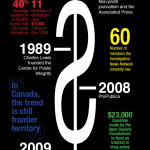Vancouver’s Downtown Eastside Is Easy to Sensationalize, Hard to Explain
A neighbourhood best known for addiction, prostitution and homelessness has long been a natural draw for journalists, but that doesn’t mean the coverage has always been good
Francis Monroe McAllister lived in Vancouver’s Downtown Eastside and died alone outside on a snowy night when the 650 shelter beds in the city were full. Mark Hume, writer for The Globe and Mail, told McAllister’s story in “Dead End Streets,” a 2006 series that painted an eloquent picture of poverty and urban struggle in one of Canada’s most notorious neighbourhoods, a place where addiction, poverty, prostitution and homelessness co-exist out in the open. “It’s easy to sensationalize,” says Hume. “You can walk in any back alley down there today, I’m sure, and find people with needles sticking out of their arms.” He also contributed stories on residents to “Canada’s Slum: The Fix,” a 2009 Globe package, but he had to fight to get the feature profiles included in the statistics-heavy project.
The Downtown Eastside is a neighbourhood beset by complex issues and for reporters unfamiliar with it, there’s temptation to sensationalize the suffering or to play the advocate. As Hume says, journalism too often “grasps at easy themes.” But the challenge is to combine humanizing coverage such as Hume’s with statistical information in a way that puts the issues of drugs, mental health and homelessness in a larger cultural context.
For most Canadians, the Downtown Eastside is represented by an image that was up front in both “Canada’s Slum: The Fix” and The Province series called “Operation Phoenix”: a skeletal hand clutching a crack pipe, with a lighter illuminating dark circles under hungry eyes. Drugs have long been a part of life in the neighbourhood—the opium trade flourished there in the early 1900s and in 1955 Maclean’s declared that Vancouver had “the highest rate of drug addiction in the Western Hemisphere.” Over the last 20 years, the loss of many low-income housing units has forced the drug activity outdoors. Repeated relapse and recovery are the natural rhythms of the area. Gabor Mate, a doctor who works in the neighbourhood and has contributed to the Globe and The Vancouver Sun, wrote a book titled In The Realm of Hungry Ghosts about the Downtown Eastside. “In a real sense,” he noted in the opening chapter, “addiction medicine with this population is also palliative work. We do not expect to cure anyone.”
In the lead up to the Vancouver Olympics, the Province sought to capture the neighbourhood and its legacy of struggle. The paper even shared with readers six principles it would use to guide its coverage as it dedicated a year to what would result in the award-winning “Operation Phoenix” project. Reporters walked the streets but also talked numbers with philanthropists, activists and outreach workers. The last piece, “Homelessness: Keep Up the Fight for Street People,” ran in January 2010 and presented six recommendations for the neighbourhood based on a year of reporting.
Despite the ambitious nature of the series, not everyone agreed it was completely successful. “It was sort of hit or miss,” says Sean Condon, executive director of Vancouver street paper Megaphone. “They did some pieces that were totally spot on and some really simplistic, sensational tripe that did no service whatsoever to the neighbourhood.” But he is even more critical of “Canada’s Slum: The Fix,” the Globe’sextensive investigative spread. “They painted it as this black hole where money disappears,” says Condon. He argues that there’s a strong community here that fights a constant battle for its identity. “I think that the Globe and Mail piece felt like it was trying to knock that away a little bit.”
Monte Paulsen, who has been writing about the neighbourhood for The Tyee and other outlets for years, is another outspoken critic of the way journalists report on the area. “Despite good intentions, I think the coverage is misinformed and harmful,” he says. “In ‘The Fix,’ they still treated addiction by and large like this moral failing.” He does, however, admit that Hume’s profiles of residents were an exception.
Paulsen is quick to point out that the Downtown Eastside is just a small part of the story when it comes to homelessness in Vancouver and Canada. Suburban homelessness is on the rise, he explains, but reporters can’t just head to one neighbourhood for an hour and come back with that story, so it is largely ignored.
Still, Jim Green, a long-time activist and former head of the Downtown Eastside Residents Association, believes journalists have a crucial role to play in the area. “If I hadn’t had access to media, I couldn’t have done 90 percent of what I accomplished,” says Green, who has been living in and advocating for the neighbourhood since 1972, when it was known simply as Skid Road. “We used to have people that actually lived in the community and wrote stories about it, which was fabulous. But having complained bitterly about all that, if I hadn’t had fair media representation, a lot of people wouldn’t be housed.”
As Hume points out, journalists have the same responsibility to the Downtown Eastside as they do to any other community—to report honestly and accurately. But, especially with this neighbourhood, reporting honestly and accurately means more than stating the facts. It also means understanding what contributes to addiction, prostitution and homelessness. And it means looking beyond those issues to ensure the Downtown Eastside doesn’t become shorthand for the country’s homelessness and mental health problems. As a resident of the area, Lani Russwurm says, “It often seems that media coverage of the DTES is a way of talking about geography so we can avoid talking about poverty.”














